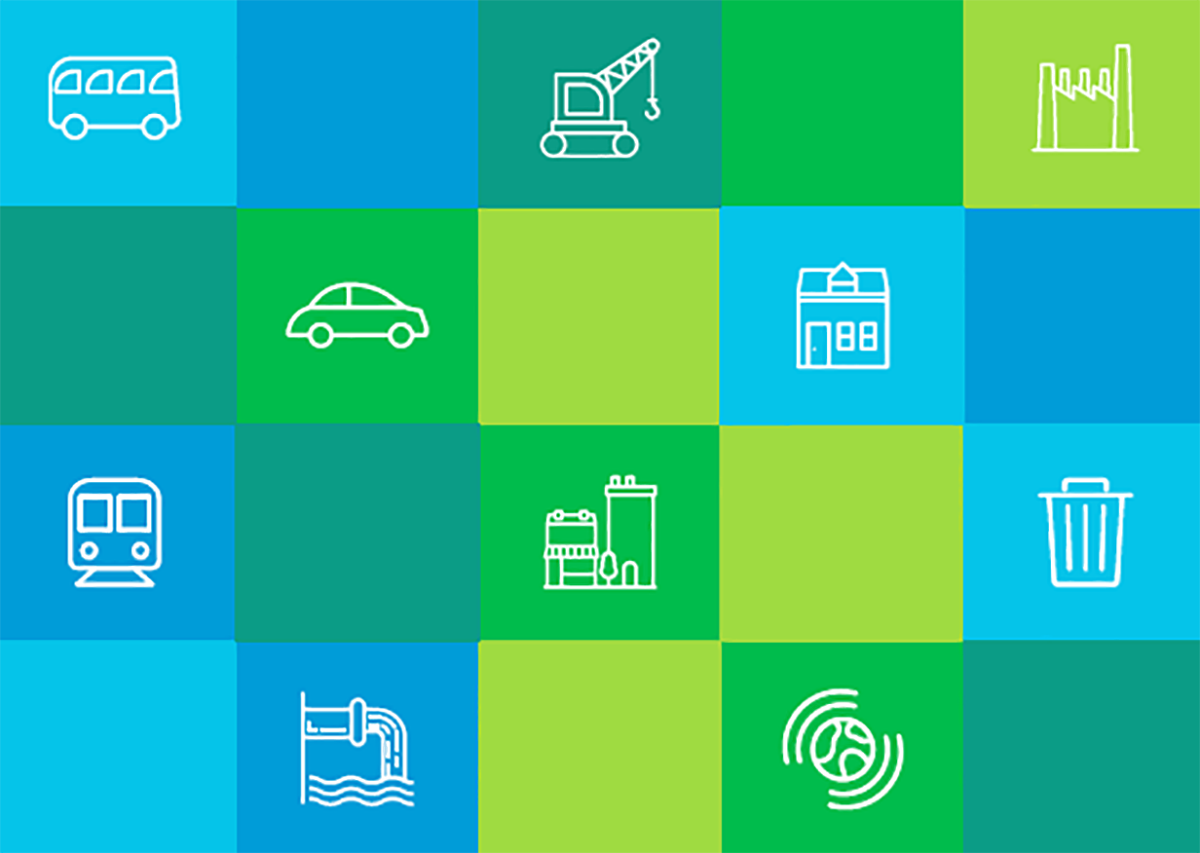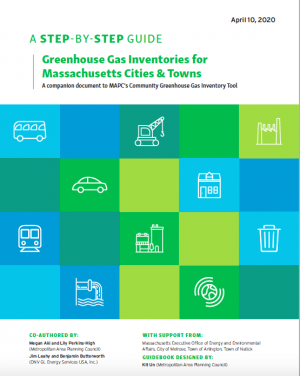
New Tool and Step-by-Step Guide: Community Greenhouse Gas Inventories
A greenhouse gas (GHG) emissions inventory is an important part of developing a data-informed climate action plan. An inventory can help identify the major sources of greenhouse gas emissions within a community; from there, cities and towns can prioritize policies and programs for reducing emissions. By consistently updating and analyzing a GHG inventory, municipalities can measure their progress and emissions reductions over time. Gathering this necessary information is an important step in the net zero planning process.
Want to learn more about net zero planning? Check out our Net Zero Planning webpage and Net Zero Framework for Action.
This week, MAPC is excited to release a new Community Greenhouse Gas Inventory Tool (“the Tool”) and accompanying Step-by-Step Guide, which outline a Massachusetts-specific approach to calculating GHG emissions from the primary local sources of emissions within cities and towns. This method, developed in partnership with DNV GL Energy Services, Inc., seeks to streamline the process for cities and towns to develop inventories of their own. The Tool is publicly available through MAPC’s website, and utilizes accessible datasets to simplify and streamline the GHG inventory process for Massachusetts municipalities.
MAPC's Step-by-Step Guide
In order to optimize MAPC’s Community Greenhouse Gas Inventory Tool, we recommend first reading through our new Step-by-Step Guide. The guide will support your community through the data collection process, provide guidance on how to fill gaps where data is not readily available, and show you how to track your community’s emissions over time.
The methodologies applied in the Step-by-Step Guide and the Tool are based on the recommended approaches in the Global Protocol for Community-Scale Greenhouse Gas Inventories.

All GHG emissions that contribute to a municipality’s carbon footprint are categorized into three sectors: Stationary Energy, Transportation, and Waste. A GHG inventory created using MAPC’s guide will include a community’s emissions from its homes, businesses, and industries; municipal operations; large energy production facilities; passenger and commercial vehicles; public transportation; natural gas leaks; electricity line losses; municipal solid waste; and wastewater. The guide provides step-by-step instructions on what data to collect and where to access data for each of the identified sectors and their subcategories for all cities and towns in Massachusetts.

Checklist to Define Local Characteristics
The Step-by-Step Guide provides a checklist of key questions about stationary energy, transportation, and waste in your community. Completing this checklist will guide you through collecting the necessary data to develop a thorough inventory, specific to your community

Data Collection Worksheet
The Data Collection Worksheet included in the Step-by-Step Guide simplifies the data input process by creating a single location to track all the data and sources needed for your inventory. The worksheet correlates directly with the Inputs section of the Tool, streamlining the data input step of using the Tool.
MAPC's Community Greenhouse Gas Inventory Tool
Cities and towns can use MAPC’s Community Greenhouse Gas Inventory Tool to establish a community-wide GHG emissions baseline. This can then be used to track changes in emissions over time, thereby demonstrating progress made toward a community’s climate goals and places where improvement is needed.
The INPUTS section is the main data entry hub of the Tool. Here, you can add all of the necessary data for each of the three major emissions sectors (Stationary Energy, Transportation, and Waste). Before inputting data into the Tool, you will complete the Data Collection Worksheet provided in the Step-by-Step guide so you have all of the data in one place.

After all the necessary data is entered, summary emissions data will be calculated in the All Emissions - Summary and Report Charts sections of the Tool. These tables include summaries of total carbon dioxide (CO2), methane (CH4) and nitrous oxide (N2O) emitted within your community. The Emissions Factors section provides a breakdown of the supporting emissions factors and unit conversion factors from the various types of greenhouse gases. An emissions factor is a measure of the amount of greenhouse gas released per unit of measurement for a particular activity (e.g., pounds of carbon dioxide emitted for each therm of natural gas used in a building).
The Tool provides informative summary tables for the user. These, however, may not be the best way to communicate the data to a broader audience. We recommend that communities utilize the Report Charts tab for a more accessible and visually appealing display of your inventory's GHG emissions data.
You can gain a deeper understanding of each subsector (such as Transportation – Rail or Stationary Energy – Buildings) by viewing its specific tab. All supporting methodologies are described in the appendices of the Step-by-Step Guide.
Resource Highlight:
Accounting for the Emissions Benefits of Green Municipal Aggregation
Unlike other inventory resources, this Tool allows cities and towns to include additional non-emitting resources (i.e. renewables) that are enabled through a Green Municipal Aggregation program.
Through municipal aggregation programs, a municipality selects and contracts with an electricity supplier on behalf of its residents and small businesses, allowing the community to purchase larger amounts of renewable energy than the state requires.
Communities with green municipal aggregation programs can easily customize the emissions factor applied to residential and commercial electricity consumption in the Tool to account for additional renewable energy within the electricity supply due to customers subscribed to the program.
Learn More
Visit our new Community GHG Inventory Resources page to download the Tool and the Step-by-Step Guide. Have questions? Please contact the Clean Energy Department at cleanenergy@mapc.org.


